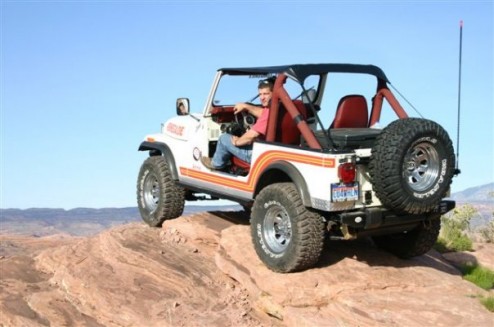
Jim Repp truly loves going to work every day. He’s been involved in the engineering of Jeep® brand vehicles for over two decades and his passion for the brand inspires everyone on his team. So strong in fact, he’d rather drive a Jeep Wrangler than a Ferrari, and he wears his Jeep tattoo on his arm like a badge of honor. We recently had a chance to sit down with him to learn a little more about his background, and what’s coming down the trail for Jeep in the near future.
Q: Tell us a little about yourself and your passion for the Jeep brand.
JR: It started when I was 14. I bought an old Jeep CJ that needed a lot of work. I hid it from my parents in my friend’s barn. It was at this point I realized I liked doing mechanical things. I grew up in farm country in Ohio and would always see Jeep 4×4’s driving down the road or in the fields, and thought what great vehicles they were. As I got older, I got into muscle cars, but that only lasted for a few years [before I] eventually fell in love with Jeep vehicles even more – especially the CJ models.
Q: How long have you been an engineer on the Jeep platform?
JR: I’ve been with Chrysler for over 20 years. After graduating from Bowling Green State University with a degree in manufacturing, I began working for Chrysler. It was an interesting time, as AMC was in the process of being purchased. I started out as a program manager on the Jeep YJ, which was technically the first “Wrangler” badged Jeep. After that, I worked on the XJ (Cherokee) and then later I was the vehicle development manager on the first and second generation Grand Cherokee (ZJ & WJ). I ran the TJ (Wrangler) from 1998-2006. One of the coolest projects during this period was the Rubicon program where myself and a fellow engineer pushed hard to get the Rubicon program approved. Also during this era, I worked on the long wheelbase TJ-based Wrangler, which led to the Unlimited and four-door models. Along the way I even turned down promotions to work on other brands because I wanted to keep working on Jeep products. I wanted to stay with the Wrangler and keep it pure to its heritage. To me, that means worlds more than a promotion working on another platform.
Q: How will the award-winning 3.6L Pentastar V6 and the five-speed automatic transmission slated for 2012 improve the overall performance of the 2012 Wrangler?
JR: The new engine and transmission combination will offer a night and day difference in on-road drivability, off-road performance and improved fuel economy over the units it is replacing. It’ll be perfectly matched to the vehicle and will offer more refinement that the customers will immediately notice. It’s just a huge step in the right direction all the way around. To optimize low-end torque, we retooled both the intake and exhaust manifold to further enhance low speed drivability characteristics. I will be buying one for myself!
Q: Jeep brand customers look for off-road capability but also expect creature comforts for daily commuting. How do you achieve this balance as it pertains to suspension tuning, tires, axle ratios and ride height?
JR: We do a lot of consumer research to find out what the customer really wants. We then design to meet the measurable benchmarks customers find very important. For example, customers want a quieter vehicle, but without compromising off-road capability. From our research, we found about 85 percent of Wrangler customers go off-roading in some capacity, whereas a much smaller percentage of Grand Cherokee owners will ever take their vehicle on trails. Therefore, while not all customers may take their vehicles off-road, they want their vehicle to be capable when they need it to be and in all situations, such as rainy or snowy weather. If we look at Wrangler customers and their lifestyle, it’s a wide spectrum that ranges from campers to hunters, extreme or casual off-roaders, to young urban drivers and even college students who want a fun and capable vehicle.
Q: Are there plans to continually develop, evolve and refine the already very capable Quadratrac® and Selec-Terrain™ systems?
JR: I don’t think it needs to get more sophisticated, as we have a highly refined system right now. There will always be technological improvements that will happen along the way that we will spearhead and implement. Technology has given us the ability to make vehicles do great things, and very well, all while satisfying the customer’s need for a great ride quality, while being fully capable on various road conditions such as mud, sand, snow, etc. For example, years ago you may have needed locking differentials, but now our Brake Traction Control (BTC) system does the job. The BTC system will help to perform in various situations just like a locking differential.
Q: Finally, do you have any Jeep vehicles of your own that you like to “play in the mud and climb rocks” with?
JR: Yes, I currently have five Jeep vehicles in my stable. I have two JKs, a couple of Cherokees and a 1970’s CJ that I really enjoy driving. There are many people who work on the various Jeep teams that own and work on their own vintage models. It’s not unusual for us to get together and go off-roading. For me and my associates, it’s more than just a job, it’s a lifestyle.
Q: It’s on all of our minds, when will we see a diesel and/or a V8 in a Wrangler?
JR: We use many of the Jeep events throughout the year to get feedback from enthusiasts and these two topics often come up. At the end of the day it’s a business decision with many factors, such as how much it will cost to produce and is this something that will be cost-effective to our customers.
Q: Are there college internship opportunities with Chrysler?
JR: We are always looking for young and fresh engineering talent from all backgrounds. Young people have a different, fresh perspectives and viewpoints, which are very important to attract future customers. I would highly recommend going to the Chrysler Careers website and checking out the careers section.
Q: Have you guys considered making a bare-bones Wrangler for off-road enthusiasts?
JK: Absolutely, just look at the Jeep “Pork Chop” concept that we showed at the Jeep Easter Safari earlier this year. We built this to gauge people’s interest of a basic stripped-down Wrangler that’s very utilitarian. One of our jobs as engineers and a corporation is to listen to the customers, because if we don’t build what you want, the way you want it, you’re not going to buy it.

